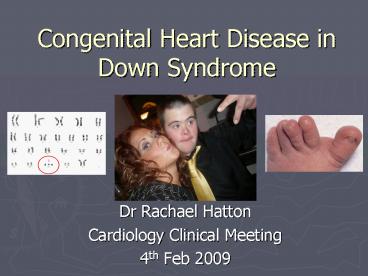Congenital Heart Disease in Down Syndrome PowerPoint PPT Presentation
1 / 37
Title: Congenital Heart Disease in Down Syndrome
1
Congenital Heart Disease in Down Syndrome
- Dr Rachael Hatton
- Cardiology Clinical Meeting
- 4th Feb 2009
2
Case History Baby N
- Born at 384 weeks.
- Normal vaginal delivery following an
uncomplicated pregnancy. - At delivery was noted to be dysmorphic.
- Long torso, short limbs. Single palmar creases,
low set ears, moon-like facies, 3 fontanelles. - Provisional diagnosis of Down Syndrome
3
Case History Baby N
- Loud single S2. No murmur.
- Liver palpable 2 cm below costal margin.
- PDx pulmonary hypertension due to pre-birth
asphyxia (meconium staining of the amniotic fluid)
4
Day 5
- Respiratory distress.
- Tachypnoea RR 80. Occasional desaturations to 82
on room air. 99 on oxygen. - No accessory muscle use.
- 1/6 systolic murmur at the left lower sternal edge
5
Investigations
- Chest XRay Normal
- ECG
6
ECG
- Extreme left axis deviation (abnormally superior
axis) - No conduction disturbance
7
Differential Diagnosis?
- - AV septal defect
- - Univentricular heart
- - Hypoplastic right ventricle
- Where to next?
8
Echo
9
Echo
10
Echo
11
Cardiac Embyrology
12
Cardiac Embryology
13
Development of the Interatrial Septum
14
By day 50
15
Congenital Heart Disease in Down Syndrome
- 40 of Down Syndrome newborns have one or more
major cardiac defect - Down Syndrome accounts for 35 of all AVSDs
16
Complete AVSD - Pathology
- Large septal defect
- Common atrioventricular valve
- Regurgitation
17
Complete AVSD - Pathology
- Three subtypes
- Type A frequent in Down syndrome, usually an
isolated defect
18
Clinical Manifestations
- Tachypnoea, failure to thrive
- Pulmonary hypertension
- Murmurs
19
Echocardiography
- Primary diagnostic tool
- Assessment of differential diagnoses
- Assess for coexisting malformations
- Assess for ventricular imbalance
20
Radiography
- Cardiomegaly
- Right atrial enlargement
- Left atrial enlargement
- Pulmonary markings
21
ECG
- Prolonged PR interval
- Atrial enlargement
- Frontal axis deviation
- Ventricular hypertrophy
22
Cardiac Catheterisation
- Rarely needed
- Gooseneck deformity of the LVOT on LV gram
23
Down Syndrome and AVSD
- More likely to have complete AVSD and associate
ToF. - Extent and progression of pulmonary vascular
changes is controversial. - Haemodynamic assessment must incorporate
comorbidities seen in Down Syndrome.
24
Surgical Repair
- Untreated, complete AVSDs carry a poor
prognosis. - Surgery usually undertaken in infancy
- Patch repair and valve reconstruction
25
Reoperation after Repair
- 17 during 20 years post repair
- Long-term echocardiographic monitoring is required
26
Long-term outcomes Is Down Syndrome a Risk
Factor for Poor Outcome after Repair of
Congenital Heart Defects?
- Journal of Paediatrics 1998
- 3965 patients
- 289 (7) had Down Syndrome
27
Long-term outcomes Is Down Syndrome a Risk
Factor for Poor Outcome after Repair of
Congenital Heart Defects?
28
Long-term outcomes Is Down Syndrome a Risk
Factor for Poor Outcome after Repair of
Congenital Heart Defects?
- No significant difference for other malformations
29
Long-term outcomes Is Down Syndrome a Risk
Factor for Poor Outcome after Repair of
Congenital Heart Defects?
- Age at reparative surgery younger for Down
Syndrome patients - Why?
30
(No Transcript)
31
(No Transcript)
32
(No Transcript)
33
(No Transcript)
34
Reasons for Reoperation
- Incompetence of the LAVV
- Others
35
Conduction Disturbance
- No significant difference
- Small proportion requiring PPM
36
A Short Note on Genetic Counselling for Down
Syndrome
- Extra chromosome 21 vs translocational trisomy 21
- Genotype testing of the affected infant
37
(No Transcript)

